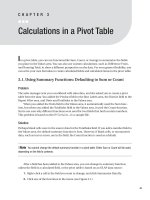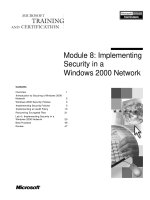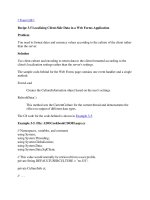any port in a storm
Bạn đang xem bản rút gọn của tài liệu. Xem và tải ngay bản đầy đủ của tài liệu tại đây (662.82 KB, 16 trang )
Chapter 13
Any Port
in a Storm
Chapter 13
Any Port
in a Storm
It was Friday evening, prime time for playing rounds of online games with friends
from school. Douglas, a 15-year-old boy from Novato, California, had—as usual—gone
straight from the dinner table to the Net.
Douglas is a serious gamer. He has every game system on the market. He even has two
Microsoft Xbox 360s, a Sony Playstation 3, and a Nintendo Wii in his bedroom. Need-
less to say, he also spends time playing his favorite game, World of Warcraft, on the
Internet. In the middle of the game, he lost his connection and was dropped from the
gaming site. The following mes-
sage flashed across his computer
screen.
Connection Lost Out of
Bandwidth!!!
Douglas was annoyed that he
couldn’t finish his game and had
no clue what that message meant.
He started to wonder if he’d been
dropped off because of the firewall
on his parents’ network. Douglas
turned off the firewall, entered
the gaming site and began to play
his favorite game again. No drop
off this time. Douglas decided to
leave the firewall off while he was
playing his game on the Internet.
176
Chapter 13
While turning off the firewall sounded like a good idea to Douglas, that wasn’t
the problem. In fact, that created a new problem because turning off the firewall
opened the door to his parents’ home network to hackers. The bandwidth problem
had to do with the network in Douglas’s house. He really didn’t have enough band-
width coming into his house in the first place. In this chapter, you will see how you
can test your bandwidth for free. Also, this chapter talks about some of the basics
of networking and why firewalls are a critical component of security.
13.1 So What’s a Network?
A computer network is a group of computers that are connected. Sometimes this is
a physical connection using wires, cables, telephone lines or some combination of
the three. Sometimes, as with “hot spots” and wireless networks, there is no physi-
cal connection. In all cases, however, the computers within a network are con-
nected in a way that allows their users to share resources like files and/or physical
devices like printers.
At school, the school’s network is what allows you to create your research papers
in one computer lab but pick up your printout in another. This is also what allows
your teacher to enter grades at the computer on her desk and pick up printouts of
student progress reports in the teacher’s lounge.
Computer networks have been around for a long time, and several technologies
have been developed to enable computers to communicate. One of the most suc-
cessful is a technology called
Ethernet
, invented by Bob Metcalfe in 1973.
Ethernet Ethernet lets computers on a Local Area Network (LAN), such as in an office
building, connect to one another and to other network resources, such as servers.
Today’s computer networks come in many shapes and sizes. They can be HUGE.
A major university might have a computer network that connects thousands of
students, faculty, and staff. A computer network can also be quite small. Consider
the network at Douglas’s house. That network connects just three computers—one
for Douglas, one for his mom, and one for his dad. Because they’re using network
technology, the whole family can use the same Internet connection and send files to
the same printer.
Any Port in a Storm
177
Regardless of their size, all networks work pretty much the same way and provide
the same functions. That is, they all use one
protocol
or another to allow the
computers and other devices in the network to talk to each other, and they all pro-
vide shared access to network resources. It’s also possible for some resources in a
network to be shared by some users but not others. This is why you can’t send files
to that printer in the teacher’s lounge.
Protocol A protocol is a set of rules that computers use to communicate with each
other.
The world is literally filled with computer networks!
One network can include all or part of another network. For example, the com-
puter in your mom’s home office is obviously part of your home network. How-
ever, it might also be connected to your mom’s work network. It’s also part of
a network that includes all the machines that use the same
Internet Service
Provider
(ISP). And, all of those machines are also part of the massive World
Wide Web. So, we have networks inside networks inside other networks.
ISP Internet Service Provider. This is the company that provides the network that allows
your computer to connect to the Internet.
178
Chapter 13
13.2 How Networks Communicate—TCP/IP
Being part of a network is like being part of a community. In a community, life
runs smoothly only when the people who form the community talk to each other.
To share community resources, the members of the community need to communi-
cate in ways that everyone can understand.
Computer networks are much the same. For computers to share resources, they
need to communicate using a common language. In computer terms, that common
language is called a protocol. A protocol is just a set of rules that computers use to
communicate with each other.
TCP/IP
is the protocol used most often to communicate on the Internet. TCP
stands for transmission control protocol. When you “transmit” something, you are
sending it somewhere. Thus, a “transmission” is whatever it is you are sending. So,
TCP is the protocol that controls how things are transmitted on the Internet. In
specifics, TCP works by sending data in blocks called packets. (When data is sent
over the Internet, it is divided up into blocks of data called packets.) IP stands for
Internet protocol and describes how computers send those data packets from one
computer to another.
TCP/IP The protocol that most computers use to communicate on the Internet.
13.2.1 IP Addresses
For data packets to travel safely from one computer to another, the control proto-
col needs to know where the packets are going. It needs an IP address to send the
packets to. It also needs to know the address the packets are coming from so that it
can send a reply back to let the sender know that everything arrived safely.
Just like your house has a mailing address, every computer on the Internet has an
IP address. Each IP address contains four groups of numbers separated by periods.
For example, 192.168.1.1 is an IP address. Depending on what kind of Internet
connection you have and how your ISP assigns addresses, you may have a static IP
address or a dynamic IP address.
Any Port in a Storm
179
A static IP address is always exactly the same. Like your house address. That ad-
dress is assigned when the house is built and it stays the same as long as the house
is there. While your house address is assigned by the post office, your computer’s
IP address is assigned by your ISP, or possibly by indirectly connected machines if
you have a private home network.
The advantage of having a static address for your house is that once a person
learns your address, that person will always know your address. With IP ad-
dresses, this is a disadvantage. Once a hacker learns a static IP address, he would
always know how to get back to that specific computer.
A dynamic IP address is issued when you connect to the Internet on any given day
and you keep that address only until you log off the Internet or shut down your
computer. The next time you connect to the Internet, you get a new (and probably
different) IP address. Dynamic IP addresses help to protect you from being tar-
geted repeatedly by a hacker trying to break into your computer. Your ISP assigns
dynamic addresses from a pool of addresses available to that ISP. The protocol that
manages the assignment of IP addresses is called
DHCP
(dynamic host configura-
tion protocol).
DHCP Dynamic host configuration protocol. DHCP is the protocol that an ISP uses to
assign dynamic IP addresses.
Whether you have a static IP address or a dynamic IP address depends on two
things: (1) what type of Internet connection you have, and (2) the policies of
your ISP.
If your connection is always on, and you have a static IP address, attackers have
a better chance of being successful at attacking you. It’s simple to see that if you
always have the same IP address you are easier to find. That does not mean that
dynamic IP addresses are safe, however.
To find your IP address, first make sure that your computer is connected to the
Internet. Now, click Start > All Programs > Accessories > Command Prompt. This
will open a command prompt window.
180
Chapter 13
Enter the ipconfig command at end of the C:\...> prompt line. The window that
displays next lists your IP address.









